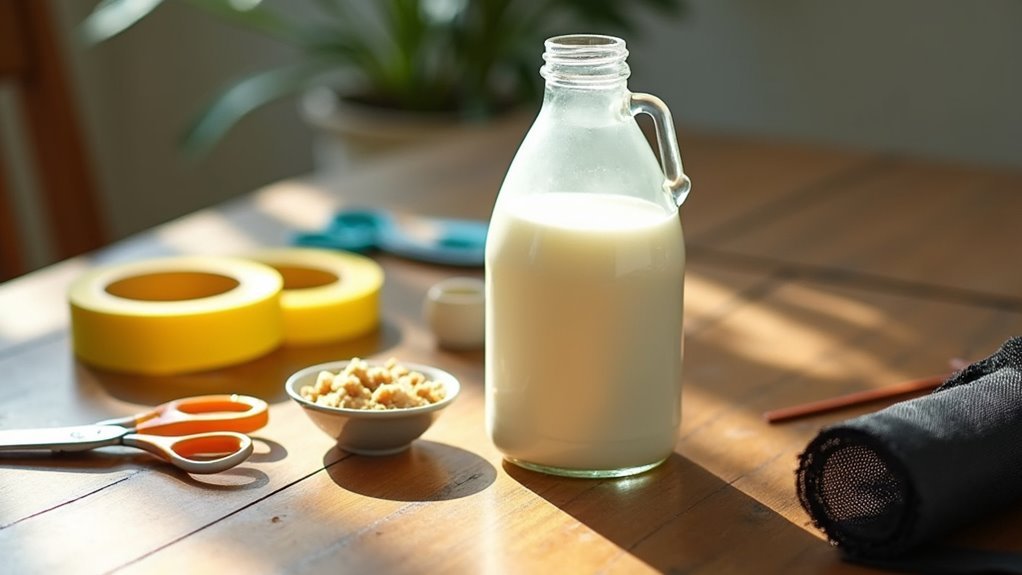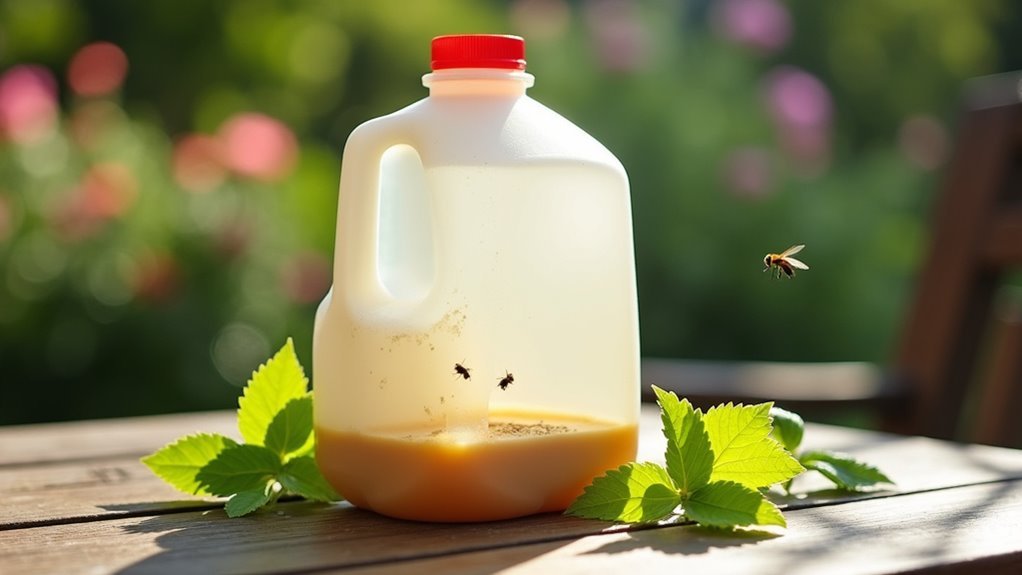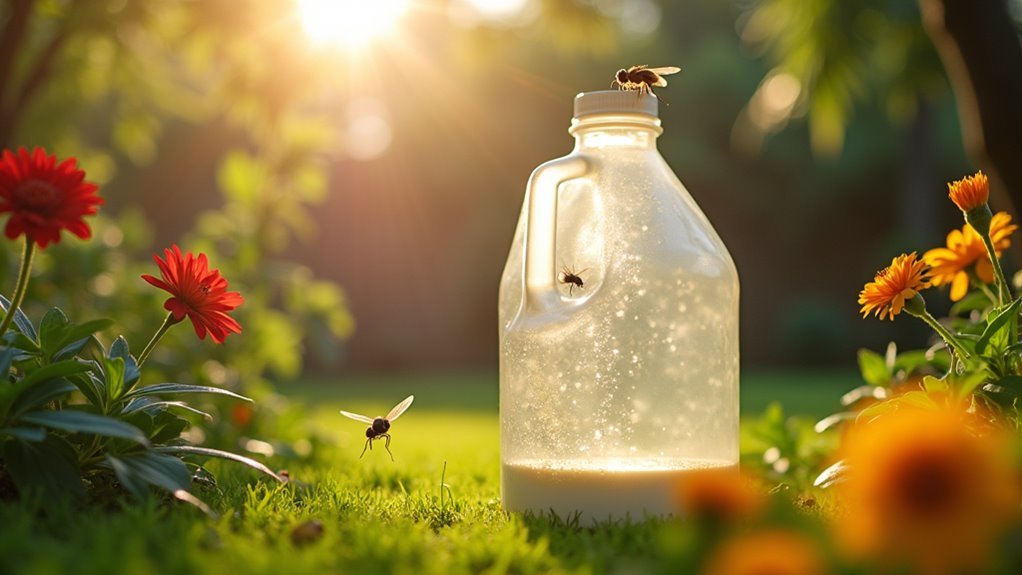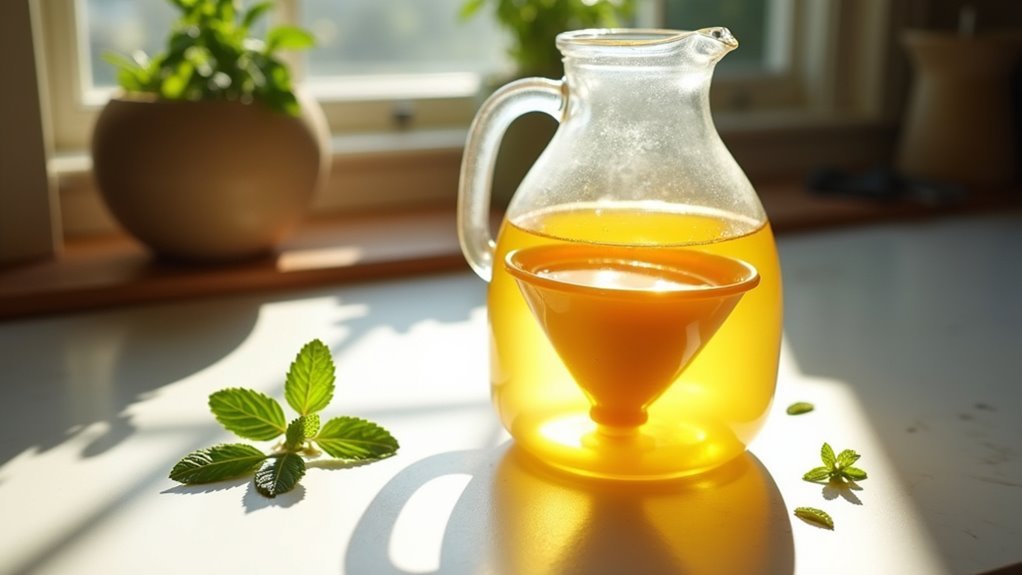To make a milk jug fly trap, you’ll cut off the top third of a clean gallon jug and create an X-shaped opening near the top. Mix equal parts water, white vinegar, and sugar as bait, then pour this mixture into the jug until it’s two-thirds full. Remove the cap completely and position your trap within three feet of high fly activity areas like garbage cans or fruit trees at shoulder height. Follow our complete guide for ideal placement strategies and maintenance tips.
Materials Needed for Your Milk Jug Fly Trap

Simplicity makes this DIY fly trap project accessible to anyone with basic household items.
This straightforward project requires only everyday household materials, making it perfect for anyone wanting an immediate pest control solution.
You’ll need a clean, empty 1-gallon milk jug as your main container for this effective homemade fly trap. Gather a small water bottle that’ll serve as an insert mechanism.
For the bait mixture, collect white vinegar, granulated sugar, and water in equal proportions—approximately 2 cups of each ingredient.
You’ll also need a sharp knife or scissors to cut the water bottle top and create an X-shaped opening in the milk jug.
That’s everything required to construct your trap. These common materials transform into a powerful fly control solution that rivals commercial options while costing considerably less than store-bought alternatives.
Step-by-Step Construction Guide
Five simple steps transform your gathered materials into a functioning fly trap that’ll capture pests effectively.
Start by cutting off the top third of your clean milk jug, creating space for bait insertion. Next, make an X-shaped cut near the top where you’ll insert a small water bottle’s neck, forming an entry funnel that prevents flies from escaping.
Now prepare your bait mixture using equal parts:
- Water (2 cups)
- Vinegar (2 cups)
- Sugar (2 cups)
Pour this solution into your jug, filling approximately two-thirds full. The sweet-sour combination attracts both common flies and fruit fly species.
Leave the cap off to guarantee easy access. Your homemade fly traps are now ready for deployment in high-activity areas.
Proper Placement and Setup Tips

Strategic placement determines your trap’s success rate, so position it within three feet of areas where flies congregate most heavily.
Target cattle water tanks, fruit trees, and garbage areas where fly activity peaks. Hang your milk jug at shoulder height to guarantee easy fly access while protecting pets and livestock from interference.
Remove the cap completely to create an unrestricted entry point that prevents escape.
If you’re dealing with limited space, consider using a small water bottle following the same principles. For enhanced effectiveness, attach sticky tape around the jug’s exterior to catch flies that approach but don’t enter.
Monitor your trap weekly and relocate it to busier areas if needed.
Replace contents annually to maintain peak performance and prevent unpleasant odors from developing.
Bait Options and Effectiveness
While various baits will attract flies to your milk jug trap, the most effective combination uses one-third water, one-third vinegar, and one-third sugar to target multiple fly species including horse flies and mosquitoes.
This mixture forms the foundation of successful fly trapping, but you can enhance results considerably by exploring different bait options.
Adding meat creates an important part of your trap’s appeal, as decomposing organic matter produces strong odors that draw flies effectively.
Raw shrimp proves particularly potent, capturing hundreds of flies within four days.
For odor-conscious users, consider these alternatives:
- Non-smelling corn as a neutral attractant
- Molasses for sweetness without strong scents
- Regular bait replacement to maintain freshness
Maintenance and Seasonal Care

Once you’ve established your milk jug fly trap with the right bait mixture, proper maintenance becomes the key to long-term success.
Check your traps regularly throughout the season, emptying them when they become saturated with deer flies and other insects. Replace the liquid when it becomes too foul-smelling, using the same old fashioned recipe of equal parts water, vinegar, and sugar.
Regular trap maintenance ensures optimal performance – empty saturated traps and refresh the water-vinegar-sugar mixture when odors become overwhelming.
Position traps where insect activity is highest, adjusting locations as fly populations shift seasonally.
Secure jugs firmly to tree branches or stable surfaces to prevent wind or animals from knocking them down.
Replace the entire trap annually to prevent decomposing material buildup that deters insect attraction and maintains peak capture efficiency.
Frequently Asked Questions
What Liquid Works Best for a Homemade Fly Trap?
You’ll find apple cider vinegar mixed with sugar or syrup works exceptionally well. The water-vinegar-sugar mixture (equal parts) attracts many flies effectively. Rotting shrimp creates the strongest odor but isn’t practical indoors.
How to Make a Fly Trap With a Milk Bottle?
Cut the milk bottle’s top section off, then make an X-shaped cut to insert a smaller bottle’s neck as a funnel. Fill with water, vinegar, and sugar mixture to attract flies effectively.
How to Make a Homemade Fly Trap?
You’ll need a container, cutting tool, and bait. Cut an entrance hole, add sweet liquid mixture or rotting protein inside, then place it where flies gather most frequently for best results.
What Is a Homemade Recipe for Getting Rid of Flies?
You’ll mix equal parts water, vinegar, and sugar in a container to create an effective homemade fly trap. This sweet-sour combination attracts flies naturally, trapping them once they enter the mixture.
In Summary
You’ve now got an effective, budget-friendly fly trap that’ll keep your outdoor spaces more enjoyable. Remember to refresh your bait weekly and clean the trap regularly for best results. During peak fly season, you might need multiple traps around your property. This simple DIY solution works just as well as store-bought versions while saving you money. Keep experimenting with different baits to see what works best in your area.





Leave a Reply